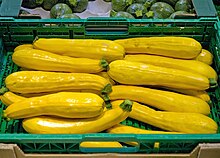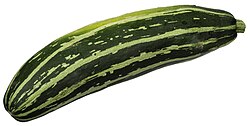| Zucchini | |
|---|---|
Striped and uniform-colored zucchini | |
| Genus | Cucurbita |
| Species | Cucurbita pepo |
| Origin | 19th-century northern Italy |
The zucchini (/zuˈkiːni/ ; pl.: zucchini or zucchinis),[1] courgette (/kʊərˈʒɛt/) or baby marrow (Cucurbita pepo)[2] is a summer squash, a vining herbaceous plant whose fruit are harvested when their immature seeds and epicarp (rind) are still soft and edible. It is closely related, but not identical, to the marrow; its fruit may be called marrow when mature.[3][4][5]

Ordinary zucchini fruit are any shade of green, though the golden zucchini is a deep yellow or orange.[6] At maturity, they can grow to nearly 1 metre (3 feet) in length, but they are normally harvested at about 15–25 cm (6–10 in).[7]
In botany, the zucchini's fruit is a pepo, a berry (the swollen ovary of the zucchini flower) with a hardened epicarp. In cookery, it is treated as a vegetable, usually cooked and eaten as an accompaniment or savory dish, though occasionally used in sweeter cooking.
Zucchini occasionally contain toxic cucurbitacins, making them extremely bitter, and causing severe gastero-enteric upsets. Causes include stressed growing conditions, and cross pollination with ornamental squashes.[8]
Zucchini descends from squashes first domesticated in Mesoamerica over 7,000 years ago,[9] but the zucchini itself was bred in Milan in the late 19th century.[10]
- ^ "Zucchini". Merriam-Webster. Retrieved 2013-09-15.
- ^ "ITIS - Report: Cucurbita". The Integrated Taxonomic Information System. Retrieved 2023-06-26.
- ^ Austin, Gareth (Jul 23, 2010). "BBC Dig In blog". Dig in Blog. BBC. Retrieved 2016-04-11.
Courgettes are commonly described as marrows harvested young. However, there are some slight horticultural differences between courgettes and marrows. Courgettes tend to be bushy and thin-skinned, whereas marrows tend to trailing and have a thicker skin.
- ^ "The Gardener's Almanac, entry at "Marrow"". Retrieved 2023-06-26.
The general difference between Marrows and Courgettes / Zuchini is: Marrow plants tend to trail out and the fruit skin is quite thick, whereas Courgettes grow as a bush and the skins are quite thin.
- ^ Dr. D.G. Hessayon (2009). The Vegetable and Herb Expert. London: Expert Books.
- ^ "Summer Squash". University of Illinois Extension. Retrieved 2013-09-15.
- ^ VanderBrug, Michael. The Timber Press Guide to Vegetable Gardening in the Midwest.
- ^ "Zucchini (courgette)". foodsafety.asn.au. Retrieved 2023-04-04.
- ^ "Cucurbits". www.hort.purdue.edu. Retrieved 2021-01-03.
- ^ Teresa A. Lust; Harry S. Paris (2016). "Italian horticultural and culinary records of summer squash (Cucurbita pepo Cucurbitaceae) and emergence of the zucchini in 19th-century Milan". Annals of Botany. 118 (1): 53–69. doi:10.1093/aob/mcw080. PMC 4934399. PMID 27343231.

